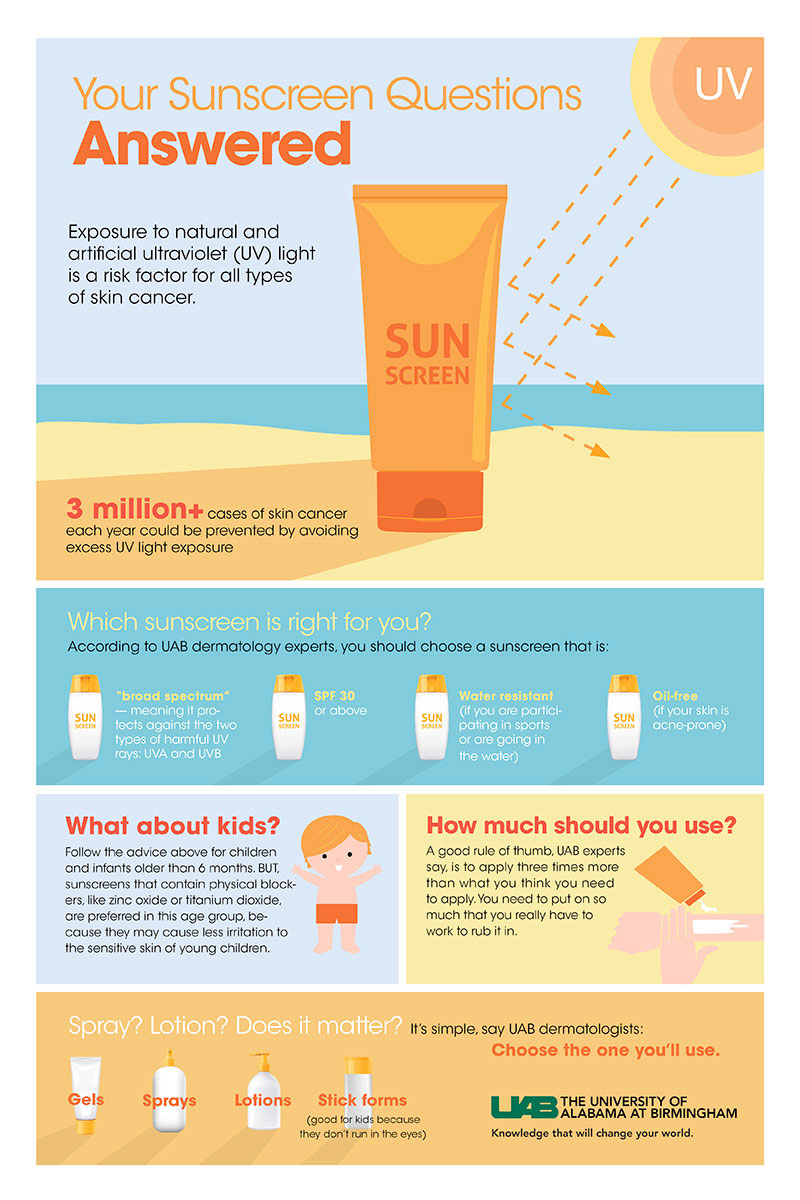Human skin is the body’s largest organ, providing protection to muscles, bones, ligaments and organs. According to the Centers for Disease Control and Prevention, skin cancer is the most common type of cancer in the United States.
“Skin cancer, like all types of cancer, is capable of destroying healthy tissue and spreading to distant body sites,” said C. Blake Phillips, M.D., a fellow in the University of Alabama at Birmingham Department of Dermatology. “If undetected or untreated, skin cancers lead to loss of vital functions or death. It is important to keep an eye on your skin and watch for changes that could be a sign of skin cancer.”
Types of skin cancer
There are many types of skin cancer with varied causes, most commonly ultraviolet radiation directly damaging skin DNA.
The three most common types of skin cancer are basal cell carcinoma, squamous cell carcinoma and melanoma.
Basal cell carcinoma is the most common type of skin cancer, and the least prone to spread from the primary tumor site. It is a locally destructive cancer, and if untreated can become a bleeding sore that eventually destroys the structures it overlies. When skin cells are exposed to ultraviolet rays, the DNA can become damaged over time, leading to the potential for basal cell carcinoma growth. People with a history of sunburn are more susceptible to this type of skin cancer.
The second most common skin cancer is squamous cell carcinoma, which is most commonly due to chronic sun exposure. It is both locally destructive and prone to spreading to lymph nodes and other organs.
Melanoma is highly capable of spreading and can be rapidly deadly if not treated. Acral lentiginous melanoma is often seen on the palms, soles and under the toenails of patients with darker skin.
“Over a lifetime, it’s quite common for high-risk patients to develop multiple skin cancers on different body sites,” Phillips said. “That said, most skin cancers have an excellent cure rate if detected and treated early. I encourage learning the signs of skin cancer and self-exams between clinic visits. Patient awareness is extremely helpful in early diagnosis.”
Risk factors
Most skin cancers are the result of exposure to radiation from the sun or other sources. UV radiation from the sun directly damages the skin DNA of susceptible people. Over time, this damage can build up, leading to the formation of cancerous cells, which grow into tumors. Sources of artificial UV rays, such as tanning beds and manicure UV lamps, also contribute.
Genetics plays a large role in underlying risk for sun-induced cancers and seems to be more important in melanoma.
Global location matters since the sun’s UV radiation is most intense near the equator. This means that living in the Southeast increases the risk for skin cancer when compared to the northern United States or Canada.
“Anyone with skin is at risk for developing skin cancers, though the common types and locations vary by ethnicity,” Phillips said. “While less common, even those with heavily pigmented skin can develop skin cancer.”
The strongest risk factors include fair skin with a tendency to sunburn, red hair or light hair, light eyes, growing up in southern latitudes, history of numerous sunburns (especially peeling or blistering burns), outdoor jobs or hobbies, routine and longstanding sun exposure, family history of skin cancers, age, prior radiation treatments, chronic lymphoma or leukemia, and immune system-altering medicines.
Signs and symptoms of skin cancer
 Signs of non-melanoma skin cancers include new red lesions that steadily grow, non-healing sores or crusted areas on the skin, bumps with a “pearly” or translucent surface, and any tender growths on the skin’s surface.
Signs of non-melanoma skin cancers include new red lesions that steadily grow, non-healing sores or crusted areas on the skin, bumps with a “pearly” or translucent surface, and any tender growths on the skin’s surface.
Melanomas are darkly pigmented, discolored areas or bumps with an asymmetrical shape, irregular borders, or dark black or multicolored surface. While the majority of melanomas do not arise from moles, new or changing moles in adulthood should be examined.
“You should see a doctor if you are concerned that a lesion is changing, is newly symptomatic, or is non-healing,” Phillips said. “If you have a first-degree relative with melanoma or you have many dark moles, it’s a good idea to have a baseline skin exam by a dermatologist.”
A doctor should examine those with prior skin pre-cancers or skin cancers at least annually, with some people requiring more frequent visits.
Protecting your skin
The most important aspect of protecting your skin is to avoid UV radiation exposure from the sun.
“I recommend sunscreen with an SPF value of 30 or higher every day to exposed areas,” Phillips said. “Look for products that don’t feel greasy and block both UVA and UVB. Many regular moisturizers now contain sunscreens, making selection of a comfortable sunscreen quite easy and inexpensive.”
Wear protective clothing and wide-brimmed hats with sunglasses when out in the sun. Avoid peak sun hours of the day from 10 a.m. to 5 p.m., choosing to do outdoor activities in morning or evening hours.
“Avoid indoor tanning, and choose pigmented lotion, spray tan or no tan instead,” Phillips said.